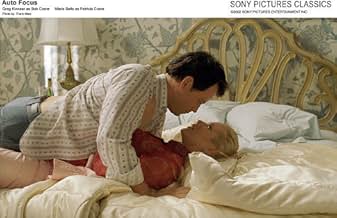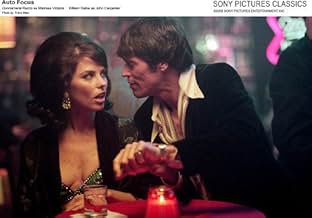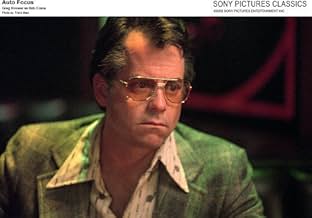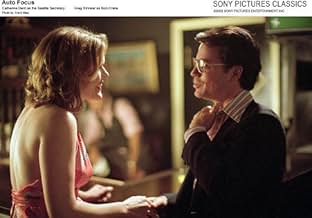La vie de la star de la télévision Bob Crane et son étrange amitié avec l'expert en électronique John Henry Carpenter.La vie de la star de la télévision Bob Crane et son étrange amitié avec l'expert en électronique John Henry Carpenter.La vie de la star de la télévision Bob Crane et son étrange amitié avec l'expert en électronique John Henry Carpenter.
- Réalisation
- Scénario
- Casting principal
- Récompenses
- 6 nominations au total
- Richard Dawson
- (as Michael Rodgers)
- Melissa
- (as Donnamarie Recco)
- …
Avis à la une
A popular star of the hit series Hogan's Heroes, Crane was a sex addict who enjoyed videotaping his sexual encounters. His partner in this endeavor was video expert John Carpenter.
Crane was murdered while doing dinner theater in Arizona. John Carpenter was a suspect in the murder, as were others. Carpenter was ultimately brought to trial and acquitted. The crime scene had been sloppily handled, and by the time Carpenter was arrested years later, evidence was missing. Carpenter died four years after his trial. The film's point of view suggests he was indeed the killer.
Crane had told his son that Carpenter was a hanger-on and he was getting ready to dump him, which police felt was a good motive for anger leading to murder.
Paul Schrader does a good job of directing, and the performances are solid from Greg Kinnear and Willem Dafoe especially. I do have to say that Kurt Fuller, a favorite of mine, was absolutely fantastic as Werner Klemperer in his role of Colonel Klink - one would have thought he was Werner - the look, the accent, the mannerisms - perfect.
Schrader shows Crane's decline, using both music and atmosphere to create what became the empty life of a man looking for something that he could never find. The DVD has a documentary about the murder on it, and his daughter states when interviewed that Crane was a wonderful father, "very doting." A sad story of the double life of someone who lit up the TV screen in the '60s.
`Auto Focus' certainly does not shy away from revealing many of the salacious details of this true-life story. Schrader deals head-on with the disturbing nature of a mind so all consumed with the subject of sex that all other aspects of life become obliterated and distorted. What's fascinating about Crane at least in the way he is depicted in this film is that he seems to have had some sort of self-destructive death wish, for not only does he risk his career by sleeping with countless women, but he insists on leaving behind the evidence by videotaping many of his encounters, and then flaunting his `accomplishments' to others in the Hollywood community. In a way, such a cavalier attitude only underlines the sickness at the core of Crane's soul which in a perverse, paradoxical way, actually makes Crane a more sympathetic figure than he otherwise might be. An enormous amount of credit for this also goes to Greg Kinnear who does a superb job of not only replicating Crane's style of acting but of showing us the tortured man Crane became in his later years. He was truly a man driven to madness by the demons within him, and we can all identify in some sense with that condition (our demons may not be sexual in nature, but they probably eat away at us just as ravenously as they did Crane). Kinnear gets outstanding support from Willem Dafoe as Carpenter, the Svengali-like figure who lures Crane into his world of photographed sex, and Ron Leibman, as Crane's well-meaning, caring agent who can do little but stand by helplessly as his client throws his career and his life away to feed this devouring passion.
The filmmakers have done an amazing job capturing the sights and sounds of the era in which the film is set. Especially impressive are the scenes recreating `Hogan's Heroes,' with Kurt Fuller, in particular, a standout as Werner Klemperer (Colonel Klink). It's also fascinating to see the evolution of videotape technology as portrayed in the film. How many of us knew that such equipment existed for home consumption as early as the mid-60's?
There's a real sadness to the final stretches of the film, made all the more poignant by having the dirge-like musical score run uninterrupted under the action. The effect is that we really get a sense of the total desolation of Crane's life at that point as he has lost his family, his career, and his self-respect to the master he chose early on to serve. The loss of his life seems almost de rigueur given all that has gone before. `Auto Focus' is not always an easy film to watch, but for its unflinching look at an often-unappetizing subject, it deserves to be seen.
The film follows the sexual exploits of Greg Kinnear as Bob Crane, the real-life star of Hogan's Heroes, who during and after the show became a full-blown sex addict, ruining two marriages and possibly sabotaging his career in the process. Willem Dafoe is John Carpenter (no, I know what you're thinking, and he's not), Crane's partner in crime who lacks Crane's charisma with women but is fed some scraps by Crane in return for his extensive knowledge of and access to video equipment. Crane's fetish is using the home video cameras to record his sexual trysts, which he reviews over and over again, looking for something that we can't see, and that he probably can't see either.
Kinnear and Dafoe's performances alone are worth the price of admission. This is the best, boldest, and most nuanced work that Kinnear has ever done. His performance is all subtlety and detail; he introduces Crane as a regular, aw shucks family man, but as the movie progresses we gradually see the facade fall as his quiet desperation and insatiable sexual appetite begin to consume him. Not content to go over the top and yell at the top of his lungs to be effective, Kinnear instead puts on a fake smile and charms with a velvety voice while openly degrading and hitting on women. The effect is one of the most genuinely creepy performances ever committed to film. Dafoe is the perfect companion to Kinnear's subtle predator; Carpenter is a pathetic loser, easily angered and easily hurt. He gets angry, yells, and does all of the things that you've seen Dafoe do in his other portrayals of guys you wouldn't want to meet in a dark alley, or a lighted one, for that matter. It's effective elsewhere, and it's effective here. Together, these men form a pair so utterly joyless and shallow that just seeing them on-screen together made my stomach churn. Their dialogue is only incidental, usually reminiscing on previous sexual escapades or planning new ones, but it's the little tics, gestures, Kinnear's untouchable confidence foiled by Dafoe's insecurity, Kinnear's hidden hunger foiled by Dafoe's overt desperation, that give these scenes their resounding power.
Not to shortchange Schrader's direction, though, which as usual is right on target for the material. He begins in a brightly colored, idealized suburban landscape, filled with all of the usual imagery you'd expect in this sort of light-hearted period and location. Then, slowly, he slides into darker territory, carrying us into the decadent seventies, breaking shots into shorter lengths, shaking the camera, depicting with his cinematography and editing the fall of his protagonist. Admittedly, the techniques Schrader employs here to depict Crane's breakdown have been used many times before, but I still found them extremely effective here.
For the last thirty minutes of the film, I felt genuinely ill; not because I thought the projector was out of focus, as many have complained, but because Schrader and Kinnear were taking me to a dark place and immersing me in it. As I said before, this type of film is not for everybody, but for those interested in the dark side of man, this film is not to be missed. I think that at the very least, the merit of these depressing morality tales is that they provide an exact blueprint of the way not to live our lives. I suppose that showing Crane checking himself into therapy and dealing with his problems and utimately healing himself would be valuable as well, but it wouldn't make for a good film, or a true one. Some people argue against the very existence of this type of movie. My response to them is that in real life for every strong-willed person who solves their problems and triumphs over adversity, there is another loser who ultimately fails to deal with life and implodes upon their own insecurity and weakness. Until this changes, someone needs to continue making these films.
Le saviez-vous
- AnecdotesThe leather jacket that Greg Kinnear wears while playing Bob Crane in the Papa Schultz (1965) scenes of this movie is the one that the real Crane actually wore during the filming of that TV series. Crane's son Robert David Crane loaned the jacket to Kinnear for this movie. Prior to the original "Hogan's Heroes" show, Frank Sinatra wore this exact same jacket in L'express du colonel von Ryan (1965).
- GaffesThere is a glimpse of the famous Capitol Records building painted silver. At the time of the film, it was actually painted black to resemble a stack of records.
- Citations
Bob Crane: I think it's perfect for me. I mean, this character Hogan, he's quick on his toes, he's hip, he's a con artist. I don't wanna jinx it, but I think it's what I've been working toward my whole career!
Anne Crane: Really? You've been working towards a Holocaust comedy?
Bob Crane: Ann!
Anne Crane: What, Bob?
Bob Crane: Please, not in front of the children! They look up to me!
Anne Crane: They're small. They look up to everyone.
- Versions alternativesThe following deleted scenes appear on the DVD:
- Victoria finds Bob's body.
- Hogan's Heroes Montage
- Bob unloads drums and some dirty magazines fall out.
- Anne and Bob talking by the pool.
- Anne in the darkroom.
- ConnexionsFeatured in Auto Focus: Featurette (2002)
- Bandes originalesSnap!
Written by Paul Schrader and Angelo Badalamenti
Performed by David Johansen (as Buster Poindexter)
Produced by Brian Koonin
Meilleurs choix
- How long is Auto Focus?Alimenté par Alexa
Détails
- Date de sortie
- Pays d’origine
- Site officiel
- Langue
- Aussi connu sous le nom de
- Autofocus
- Lieux de tournage
- Sociétés de production
- Voir plus de crédits d'entreprise sur IMDbPro
Box-office
- Budget
- 7 000 000 $US (estimé)
- Montant brut aux États-Unis et au Canada
- 2 063 196 $US
- Week-end de sortie aux États-Unis et au Canada
- 123 761 $US
- 20 oct. 2002
- Montant brut mondial
- 2 704 951 $US
- Durée
- 1h 45min(105 min)
- Couleur
- Mixage
- Rapport de forme
- 1.85 : 1









































